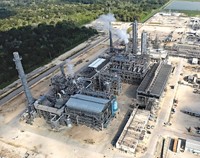Advertisement
Grab your lab coat. Let's get started
Welcome!
Welcome!
Create an account below to get 6 C&EN articles per month, receive newsletters and more - all free.
It seems this is your first time logging in online. Please enter the following information to continue.
As an ACS member you automatically get access to this site. All we need is few more details to create your reading experience.
Not you? Sign in with a different account.
Not you? Sign in with a different account.
ERROR 1
ERROR 1
ERROR 2
ERROR 2
ERROR 2
ERROR 2
ERROR 2
Password and Confirm password must match.
If you have an ACS member number, please enter it here so we can link this account to your membership. (optional)
ERROR 2
ACS values your privacy. By submitting your information, you are gaining access to C&EN and subscribing to our weekly newsletter. We use the information you provide to make your reading experience better, and we will never sell your data to third party members.
Business
Dow Sets Sights On R&D Breakthroughs
Chief Technology Officer Banholzer directs the firm's scientists to pursue raw material and process advances
by Marc S. Reisch
November 13, 2006
| A version of this story appeared in
Volume 84, Issue 46

William F. Banholzer, Dow Chemical's corporate vice president and chief technology officer, says his company, like the rest of the chemical industry, must find ways to deal with the "terrific" inflation in raw material prices of the past few years.
One way Dow tackles this problem is to invest in places like Kuwait, Saudi Arabia, and Oman. In such resource-rich countries, Dow can take advantage of low-cost natural gas to produce ethylene and derivatives such as ethylene glycol and polyethylene.
Another way to solve the raw material price dilemma is with research. Banholzer, who joined Dow from General Electric a little more than a year ago to lead Dow's $1.1 billion-per-year global R&D effort, says one of his responsibilities is to oversee research into a cheaper path to ethylene.
Banholzer, 49, occupies a position vacated when Richard M. Gross retired in 2004. He now coordinates the efforts of R&D leaders in Asia and in four corporate areas: performance products, basic chemicals, agricultural science, and central R&D. About 75% of Dow's 5,700 technical employees work within the firm's businesses, while the other 25% support its long-term growth objectives.
A chemical engineer with a Ph.D. from the University of Illinois, Banholzer is not just a bureaucrat. He spent 22 years at GE and achieved renown for breakthroughs in the development of a radar-absorbing material now used in the B-2 Spirit stealth bomber.
Earlier this year, Dow Chairman and Chief Executive Officer Andrew N. Liveris told C&EN that he brought Banholzer in from the outside to "bring fresh thinking and fresh approaches to research." He also said R&D at Dow should focus more on long-term research and less on short-term development projects (C&EN, May 29, page 10).
Banholzer says he has taken his CEO's charge seriously. "Innovation is the key value of an R&D organization," he says. At Dow, that means the emphasis should be on the discovery of brand-new products and processes. "Green" solutions are desirable, he adds, as long as they are cost-effective.
Examples of innovations that achieve both goals, Banholzer says, are new polyols from soybean oil that are better than the petrochemical-based polyols they replace. And Dow has developed a route to the epoxy resin raw material epichlorohydrin that is based on glycerin made as a by-product of biodiesel manufacturing. Dow plans to employ the technology in a plant in China that Banholzer says will be less expensive to operate than epichlorohydrin facilities now based on propylene and chlorine.
To solve the problem of high raw material costs, Banholzer is renewing emphasis on long-standing Dow research programs to develop alternative sources of ethylene, the starting material for a whole range of plastics and chemicals that Dow produces. Ethylene is now made from naphtha or natural gas.
"We are looking at catalytic dehydration of ethanol," Banholzer says, as one alternative route to ethylene. Although such a process would be practical mainly in regions such as South America, where ethanol supplies are plentiful, Dow has wider expectations for a process that would produce ethylene via oxidative methane coupling.
"The laws of thermodynamics say it is not easy to do," he acknowledges. Though scientists have been working on the process for years, the need for low-cost methane coupling is "more profound" now than ever, he says. Dow is also researching more efficient production of petrochemicals from coal.
Banholzer's efforts notwithstanding, the investment community sees Dow less as a firm whose earnings are influenced by R&D and more as one whose earnings are subject to the economic cycle. John Roberts, an analyst with the investment advisory group Buckingham Research, says Dow hasn't produced a new product with tremendous impact on profits since the early 1990s, when it introduced a new generation of plastics based on metallocene catalysts.
Banholzer hopes to change that perception. He intends to measure R&D success by quantifying the sales that Dow derives from patented products, which tend to have higher profit margins. Although the firm is interested in increasing its sales, growth is meaningful only if it is accompanied by increased profits, he notes.
Dow also has plans to expand its global research footprint. Last month it broke ground on a 65,000-m2 R&D, information technology, and administrative center in Shanghai that will contain 60 laboratories employing "hundreds" of scientists, Banholzer says. When completed in 2008, the entire facility will employ 1,800 people.
Although setting up a research facility in China involves a certain amount of risk, "innovation requires risk," Banholzer points out. "Innovation is a contact sport. It's more like hockey than golf." And the rules of engagement mean Dow must get up close and personal with its customers if it is to develop the products and processes they need tomorrow.





Join the conversation
Contact the reporter
Submit a Letter to the Editor for publication
Engage with us on Twitter